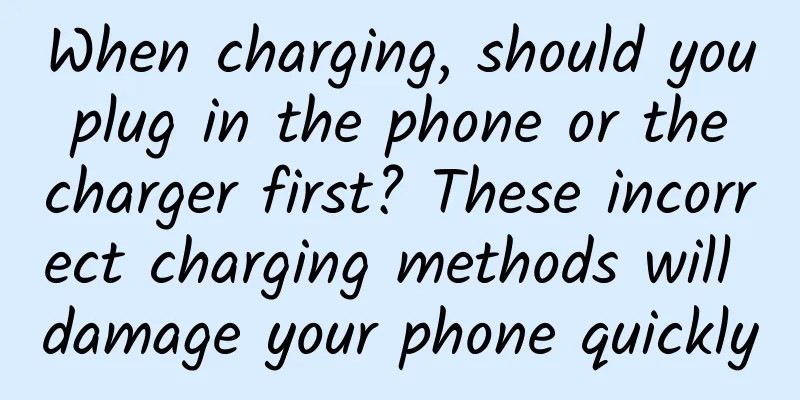When charging, should you plug in the phone or the charger first? These incorrect charging methods will damage your phone quickly

|
For many people in modern society, how much battery is left in a mobile phone is a matter of life and death. People's strong demand for mobile phone charging has also spawned many gimmicks on the market: wireless charging, twice-speed charging, and high-energy power banks that can be used for a week. There are so many options available, but what is the correct way to charge your phone? Copyright images in the gallery. Reprinting and using them may lead to copyright disputes. Does the mobile phone have to be fully charged? There are always some sayings about charging: wait until your phone is exhausted before charging, and fully charge it each time. This is beneficial to battery maintenance. Charging at any time will affect the battery life. In fact, these theories are outdated. Rechargeable batteries that were widely used in the early years, such as nickel-cadmium batteries, are mainly made of nickel hydroxide and metallic cadmium, and their disadvantage is obvious: there is a memory effect. Simply put, when the battery is not fully charged or exhausted for many times, the battery capacity will "remember" the power during charging and power failure, and regard them as the maximum and minimum power values respectively, resulting in a reduction in battery capacity. But now, nickel-cadmium batteries and other batteries have been gradually phased out due to heavy metal pollution, high weight, and low energy density, and have been replaced by lithium-ion batteries. Smart phones mostly use lithium-ion batteries, which have the following advantages over nickel-cadmium batteries: high energy density, which means that they can store more power for the same volume or weight; weak memory effect, so even if you unplug the battery before it is fully charged, it will not have any impact. The precautions for lithium-ion batteries are exactly the opposite of those for nickel-cadmium batteries: do not charge when they are out of power, do not overcharge, and there is no need to deeply charge and discharge every time. The life of a lithium-ion battery is related to the charging cycle. Every time 100% of the power is used, a cycle is completed. The more cycles there are, the more obvious the reduction in battery life. A study on 11 types of lithium-ion batteries showed that after 250 cycles, the battery capacity would significantly decay. After 300 to 500 cycles, the battery capacity will drop to 80% of its original capacity. What is the principle behind this? Data shows that when lithium-ion batteries are deeply charged and discharged, the material structure of the positive and negative electrodes will be destroyed. Lithium-ion batteries mainly rely on the movement of lithium ions between the positive and negative electrodes to work. Once the space for their movement becomes smaller, the battery capacity will also decrease accordingly. Therefore, compared to "full charging and discharging", "multiple small charges" is more suitable for current mobile phone charging habits. In addition to the power before and after charging, another issue that is easily overlooked also affects the battery life. Should I plug in the phone or the charger first? Should I plug the plug into the power supply first and then connect it to the mobile phone with the data cable , or should I connect the data cable to the mobile phone first and then plug the plug into the power supply? The answer is: the former. They are all charging, so what impact will such subtle differences have? Here is a piece of knowledge: the voltage of electricity used by Chinese residents is 220V, but the voltage of mobile phone chargers is often less than 5V. When charging a mobile phone, the charger will convert the high-voltage current into low-voltage direct current through a transformer, and then transmit it to the mobile phone. At this time, if the charger is connected to the mobile phone and then plugged into the power supply, it can be regarded as directly connecting the mobile phone to the power supply, which may output a surge voltage; conversely, if the plug is inserted first, it is already connected, and the output has stabilized at around 5V, so a surge voltage is unlikely to occur. Surge, also known as surge, refers to a momentary overvoltage that exceeds the normal working voltage. Sometimes the bright sparks you see when plugging and unplugging a switch are mostly surges. Although the duration is only one millionth of a second, it can cause considerable damage to the mobile phone battery over a long period of time. If you plug in the charger first and then connect the phone, this situation will hardly happen, unless the current itself is unstable. After charging, should I unplug the phone or the plug first? The answer is: unplug the phone first. Because when you unplug the charger, a reverse instantaneous current will be generated, which will accelerate the aging of the battery. The principle seems complicated, but it is not difficult to remember the correct order of plugging and unplugging. You can try to treat the charger, charging cable and socket as one, so that the phone is "attached" when charging, and the phone is "abandoned" when fully charged. This operation is much safer. Power banks are also popular Impact of “Charge Cycle” Many people carry a power bank with them in case they can't find a socket when they are out and about. It is indeed very convenient. A small mobile power bank can keep the phone running normally, which is simply a lifesaver. But there are also many gimmicks and misunderstandings about power banks. At present, there are many power banks on the market that claim to have a capacity of 20,000 mAh. However, most mobile phones, even the flagship version, have a battery capacity of less than 5,000 mAh. The "nail house" products of earlier years even had a pitiful 2,000 to 3,000 mAh. If you buy a 20,000 mAh power bank, wouldn't it mean that a family of three can travel for two days without worrying? When you actually buy it, you will find that it runs out of power after only two charges. Is it a false advertisement by the merchants? In fact, they are playing a word game. The capacity marked by merchants is mostly the capacity of the battery cell itself, that is, the sum of the power of multiple lithium-ion batteries in the battery. Due to power loss during the conversion process, the effective power that the power bank can provide to the mobile phone is definitely lower than this data. If you want to know how many times a power bank can actually be used, you need to carefully read the small print in the manual: rated capacity. This is the minimum discharge capacity tested in the laboratory. A media outlet once conducted an evaluation and found that the actual capacity of power banks that claim to have a capacity of 20,000 mAh can differ by as much as 4,000 mAh, which is enough to fully charge most mobile phones. It should be noted that since the power bank also uses lithium-ion batteries, its lifespan is also affected by the charging cycle. It is also recommended to "charge multiple times in small amounts" rather than "charge and discharge fully". How to charge correctly? If the use of mobile phones also has a shortcoming, the battery life is probably that shortcoming. However, in daily use, there are some charging methods that you think are correct, but in fact they are not. 1 Can’t use charging cables and chargers interchangeably? It is customary to give a charging device when buying a mobile phone, but in recent years, some manufacturers have stopped giving away chargers in the name of environmental protection, so you have to buy them yourself. The prices on the official website are too high, so many people will choose cheaper ones, thinking that charging devices themselves are consumables. If you don't keep an eye on the cat at home, the charging cable will be bitten and become unusable. This also leads to many people using the charging cable, charger and mobile phone for a short time, and perhaps the charging cable, charger and mobile phone are no longer a complete set. As a result, many rumors came out: an incompatible charger will cause the battery to short circuit and shorten its service life. In fact, this statement obviously underestimates the charger. The charger usually has a smart chip inside that identifies the current and voltage required by the phone and makes adjustments accordingly . For example, if you buy a fast charging head, but your phone does not support fast charging, the fast charging head will automatically adjust to an input power suitable for the phone. Some people complain that the fast charging head does not work. In fact, this is the principle. However, when purchasing, try to identify regular brands and don't be tempted to buy counterfeit products . After all, it is hard to say what the configuration of counterfeit chargers is. It is very likely that they will not be able to identify the current and voltage required by the mobile phone and damage the phone. 2 Don't want to charge while playing? Some people think that discharging and charging the battery at the same time will affect its lifespan. In fact, what really affects the battery lifespan is the sudden rise in temperature caused by charging while playing. Everyone has had this experience: the phone becomes hot when playing high-configuration games or using fast charging. A survey shows that even if the mobile phone is not in use, the increase in temperature will still accelerate the reduction of battery capacity. Therefore, for the sake of battery safety, it is best not to let it "multitask". In addition, it is important to note that you should not buy a protective case that is too thick for your phone. There are many fancy protective cases on the market now. They look good, but not every one of them is suitable for mobile phones. Like computers and other devices, mobile phones also need to dissipate heat. If they are wrapped tightly and with heat-insulating materials, the outside of the phone will only look scratch-free, but the inside will already be damaged. In order to avoid high temperatures, you should also pay attention not to put your phone next to your pillow or in the sun before going to bed. This action protects not only the phone, but also you. References [1]Bergveld, HJ; Kruijt, WS; Notten, Peter HL (2002-09-30). Battery Management Systems: Design by Modelling. Springer. pp. 38–. ISBN 9781402008320. Retrieved 5 June 2013. [2]"Voltage Depression ("Memory Effect")". Duracell.com. Procter & Gamble. Archived from the original on March 3, 2009. Retrieved September 15, 2015. [3]Battery University. (2021). BU-802: What causes capacity loss? [4]Understanding memory effect in Lithium-ion batteries retrieved fromhttps://evreporter.com/understanding-memory-effect-in-lithium-ion-batteries/ Planning and production Author: Li Mi Popular Science Author Review | Zhou Xiaoliang, Senior Engineer of Physics Laboratory, Beijing Jiaotong University Editor: Wang Mengru Proofread by Xu Lailinlin |
Recommend
What’s wrong with Meituan monthly payment not being used? Cause Analysis
What’s wrong with Meituan monthly payment not bei...
Galaxy Internet TV is about to rise to become one of the three largest internet TVs in the world
At present, the seven Internet TV platforms that ...
A collection of advertising creation tips that took 8 years to compile
I also summarized 12 of my own advertising creati...
Nokia Lumia 930 WP8.1 review: excellent software but lackluster hardware
At the Build conference yesterday, Microsoft rele...
The 2018 Mercedes-Benz E-Class has been significantly upgraded in terms of technology and is priced at RMB 422,800 to RMB 629,800.
According to the official website of Mercedes-Ben...
Wei An's 18 High-Paying Sales Lessons Audio
Wei An's 18 high-paying sales lessons audio, ...
The past and present life of a piece of tea - Tea Horse Road
Author of this article: Lv Weitao, Curator at the...
Audi gasoline car "cheating" scandal reappears and has been sued
According to foreign media reports, the Volkswage...
The number of followers increased by 100,000. This is how Zhihu operates and promotes!
[Zhihu, is it worth doing? " Before answerin...
Cold-resistant lithium-ion batteries, will your phone "hibernate"?
China Science and Technology News Network, Decemb...
Useful information | You will definitely find some of the community operation answers you want from this article!
Although all operations have something in common,...
If the corals are gone, where will the crabs attach themselves to?
At present, global climate change, especially glo...
Pinwan.com: New Energy Vehicle Data Inventory in 2022
The 2022 new power delivery volume list was unvei...
Really! Buy one get one free! Diamond World's "Matryoshka" is here
I believe many of you have Russian nesting dolls ...
Why did the "butt injection" that was popular when we were young disappear?
When it comes to injections, what comes to your m...









